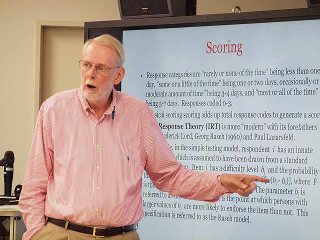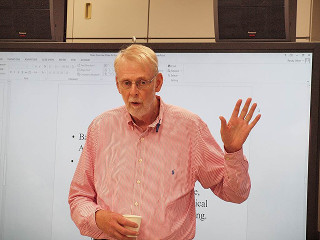Who Starts Ahead and Who Moves Ahead?
Achievement, Social Adjustment and their Production in Children
(Prof. Randy Olsen)
Date
Thursday, 11th October, 2018 13:20-14:50
Place
Open-Lab, 4th floor, East Building, Mita Campus, Keio University
Details
As Adam Smith pointed out, the wealth of nations is in their inhabitants, making the development of children central to economic development and progress. Many of the “gateways” through which children must pass on the way to adulthood can be characterized as sorting children into an ordering on social, emotional and especially cognitive outcomes. While economic development reflects aggregate child development, for individual economic outcomes, where a child ranks in their peer group has significant impacts. Prof. Olsen uses data from the Children of the NLSY79 to examine the process that sorts children by their cognition and behavioral problems.
Speaker : Prof. Randy Olsen
Staff, the Center for Human Research (CHRR), and Professor Emeritus, Department of Economics, the Ohio State University.
Professor Olsen was the director of the CHRR and has been heavily involved with the National Longitudinal Surveys of Labor Market Experience (NLS) for over twenty years. He also works on other projects at CHRR, most of which are related to applied microeconomics.
Speaker : Prof. Randy Olsen
Staff, the Center for Human Research (CHRR), and Professor Emeritus, Department of Economics, the Ohio State University.
Professor Olsen was the director of the CHRR and has been heavily involved with the National Longitudinal Surveys of Labor Market Experience (NLS) for over twenty years. He also works on other projects at CHRR, most of which are related to applied microeconomics.
Notes
Panel Data Research Center at Keio University
Institute for Economic Studies, Keio University
Center for Research on Equality of Opportunity for Children
Language : English
**This seminar is open to students, scholars and the public for free.**
■ Poster
Institute for Economic Studies, Keio University
Center for Research on Equality of Opportunity for Children
Language : English
**This seminar is open to students, scholars and the public for free.**
■ Poster
Event Reports
On the 11th of October, 2018, Prof. Randy Olsen conducted two seminars. Prof. Olsen was the Director of the Center for Human Research at Department of Economics, the Ohio State University.
In the first seminar, Prof. Olsen used Item Response Theory (IRT) to determine 1) whether the items in the Center for Epidemilogic Studies Depression scale (CES-D) perform in a comparable manner over the life course, 2) the degree to which depressivity is stable, and 3) whether the variation in the estimated measures of depression can be explained based upon IRT. CES-D is a commonly used measure to detect depression in the USA.


In the second seminar, the title was “Who Starts Ahead and Who Moves Ahead? Achievement, Social Adjustment and their Production in Children”. Prof. Olsen used data of the Children of the NLSY79 to examine the process that sorts children by their cognition and behavioural problems.


In the first seminar, Prof. Olsen used Item Response Theory (IRT) to determine 1) whether the items in the Center for Epidemilogic Studies Depression scale (CES-D) perform in a comparable manner over the life course, 2) the degree to which depressivity is stable, and 3) whether the variation in the estimated measures of depression can be explained based upon IRT. CES-D is a commonly used measure to detect depression in the USA.


In the second seminar, the title was “Who Starts Ahead and Who Moves Ahead? Achievement, Social Adjustment and their Production in Children”. Prof. Olsen used data of the Children of the NLSY79 to examine the process that sorts children by their cognition and behavioural problems.





